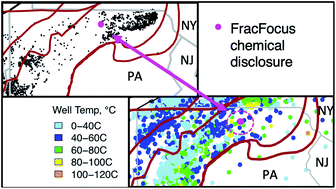A geospatially resolved database of hydraulic fracturing wells for chemical transformation assessment†
Abstract
Hydraulically fractured wells with horizontal drilling (HDHF) accounted for 69% of all oil and gas wells drilled and 670 000 of the 977 000 producing wells in 2016. However, only 238 flowback and produced water samples have been analyzed to date for specific organic chemicals. To aid the development of predictive tools, we constructed a database combining additive disclosure reports and physicochemical conditions at respective well sites with the goal of making synthesized analyses accessible. As proof-of-concept, we used this database to evaluate transformation pathways through two case studies: (1) a filter-based approach for flagging high-likelihood halogenation sites according to experimental criteria (e.g., for a model compound, cinnamaldehyde) and (2) a semi-quantitative, regionally comparative trihalomethane formation model that leverages an empirically derived equation. Study (1) highlighted 173 wells with high cinnamaldehyde halogenation likelihood based on combined criteria related to subsurface conditions and oxidant additive usage. Study (2) found that trihalomethane formation in certain wells within five specific basins may exceed regulatory limits for drinking water based on reaction-favorable subsurface conditions, albeit with wide uncertainty. While experimentation improves our understanding of subsurface reaction pathways, this database has immediate applications for informing environmental monitors and engineers about potential transformation products in residual fluids, guiding well operators' decisions to avoid unwanted transformations. In the future, we envision more robust components incorporating transformation, transport, toxicity, and other physicochemical parameters to predict subsurface interactions and flowback composition.



 Please wait while we load your content...
Please wait while we load your content...